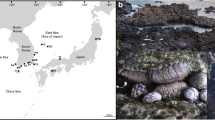Abstract.
Recent or incomplete speciation events can often lead to conflicting patterns of genetic and morphological variation, due to a combination of hybridization, incomplete lineage sorting and limited morphological divergence among genetically distinct species. This situation complicates the reconciliation of molecular systematic results with morphology-based taxonomy. For example, six-rayed sea stars of the genus Leptasterias have been the subject of considerable taxonomic controversy. Prior molecular studies established that Leptasterias subgenus Hexasterias consists of several genetically discrete clades, but extensive morphological variability has prevented the application of formal taxonomic nomenclature to these groups. In the present study, molecular and morphological approaches were combined to reconcile, where possible, the traditional taxonomy of Fisher (1930: US Nat Mus Bull 76:1–356) with recent molecular systematic results. Partial mitochondrial DNA control region sequences were collected from 29 Fisher-identified museum specimens representing seven nominal species of Leptasterias subgenus Hexasterias, to establish the relationship between traditional taxa and molecular lineages. Additional DNA sequences were obtained from 52 recently collected individuals representing the L. aleutica (Fisher, 1930)/L. camtschatica (Brandt, 1835) complex; these sea stars were collected on Kanaga Island, Alaska, in August 1997. Morphological data were collected for 227 museum specimens collected before 1930, and 309 specimens collected between 1988 and 1998 from locations in the eastern North Pacific. The analyses indicate that three nominal species within the Camtschatica section of subgenus Hexasterias, L. alaskensis (Verrill, 1914), L. hexactis (Stimpson, 1862), and L. leptodoma (Fisher, 1930), correspond to separate major clades of a molecular phylogeny, permitting the re-description of these taxa using molecular characters. Extensive sharing of mitochondrial DNA sequences by L. aleutica and L. camtschatica suggests recent genetic divergence of these two species and possible incomplete lineage sorting or frequent hybridization. The lack of diagnostic molecular differences between these two nominal species means that they are currently identifiable only by morphological criteria. Determining the status of three other nominal species, L. aequalis (Stimpson, 1862), L. asteira (Fisher, 1930) and L. pusilla (Fisher, 1930) will require additional molecular and morphological data.
Similar content being viewed by others
Author information
Authors and Affiliations
Additional information
Electronic Publication
Rights and permissions
About this article
Cite this article
Flowers, .J., Foltz, .D. Reconciling molecular systematics and traditional taxonomy in a species-rich clade of sea stars (Leptasterias subgenus Hexasterias). Marine Biology 139, 475–483 (2001). https://doi.org/10.1007/s002270100595
Received:
Accepted:
Issue Date:
DOI: https://doi.org/10.1007/s002270100595




